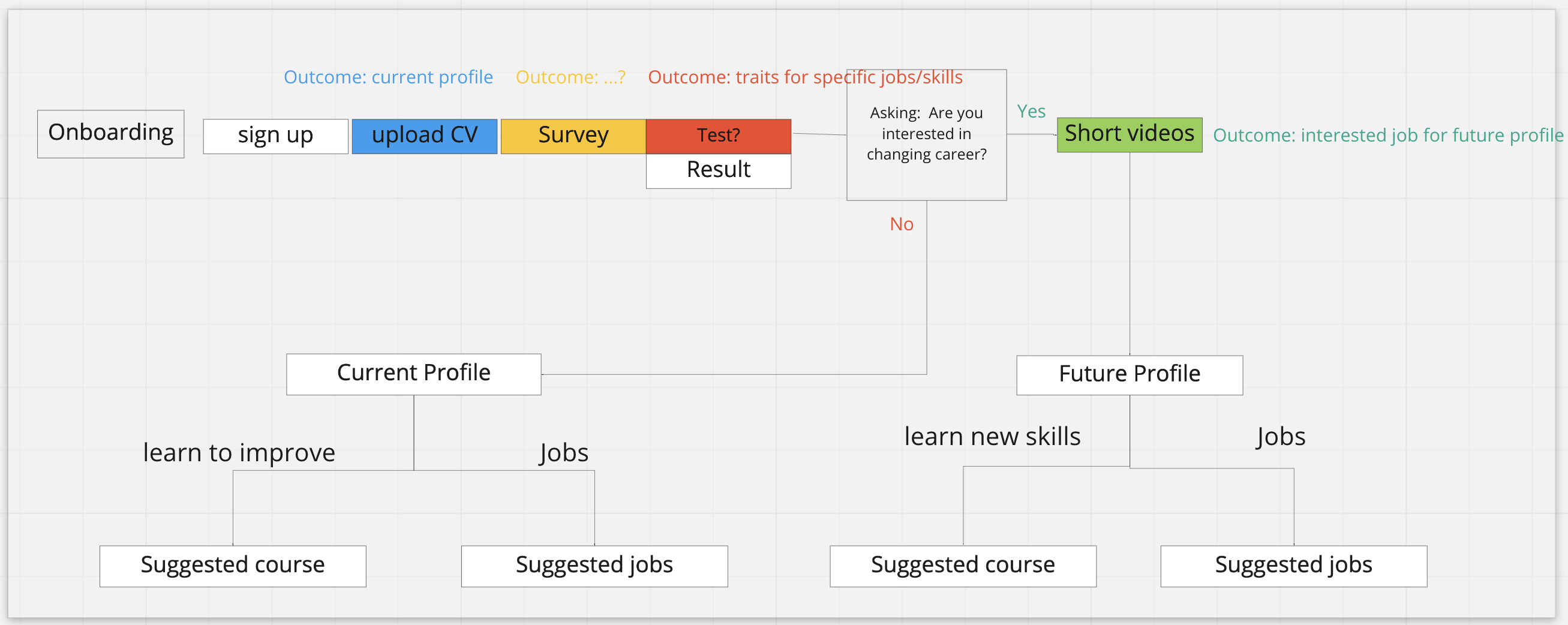I and my teammates developed SkillMatch - a fair talent matching approach the connects diverse employee profiles with the most relevant open position descriptions and proposes a motivating re-skilling journey required for a successful restart.

.png)
Participated in the two-and-a-half-day Hackathon with the challenge setter Infosys, our team has five members including developers, designers, and business strategists.
I worked through all processes from analysing the challenges, brainstorming, initiating ideas together with my team. I was also fully responsible for the high-fidelity prototyping of the design process. Due to the time constraint of the Hackathon, decisions were made quickly to save time for designing and developing the solution. Nevertheless, we did not compromise with the result's quality. By effective planning from the beginning, we managed to follow the standard design process similar to design sprints.

👉 The economic impact of the COVID-19 pandemic has made re-skilling and restarting an urgent priority for job seekers as well as employers.
👉 There should be immediate pathways for talent to transition from traditional jobs into digital jobs of the future.
👉 Ensure that every individual has the chance to succeed by connecting them with the most relevant career opportunities.
Individuals who want to develop their careers need a convenient and effective job matching solution combined with suggested strategic plans to improve their skills for future working opportunities so that they are more confident to excel at their current jobs or search for a new job.
To empathise with the users, we came up with a persona that reflected the targeted users of the app. The personas also assisted us in communicating and brainstorming our initial ideas effectively. For example, in the discussion of ideas about a specified function, instead of focusing solely on the functioning aspect of the idea, we asked and discussed whether the function would help Thomas (our personas) to achieve his goal. In that way, we could valid the ideas easier and better decide which features should be prioritised.

The team used the Miro board to brainstorm ideas together. Ideas were sorted to meet needs of different user categories such as job seekers and Infosys customers, organisations who seek employees, and government agencies who work on the employment of residents.
We defined the user journey with three stages: (1) Skill assessment, (2) Re-skill, and (3) Restart. We also researched different competitors in the market to learn what they did well and whether there was a niche that we could focus on to grant our app competitive advantages.

Based on the insights from competitive research and agreed ideas, we sketched the user flow to present the features the app offers which matched the user personas' needs.

I created the low-fidelity in Miro board to discuss ideas with the team. Based on the feedback, I was more confident to develop the wireframes further to the high-fidelity version.
After getting the ideas, I used Figma to visualise the wireframes in high-fidelity. With aiming to show the prototype at the video pitching to the client Infosys, I designed all screens needed for the user flow. After that, I added more features for the navigation bar of the app which equipped users in their re-skill and restart career journey
.png)
After providing basic personal information and uploading the CV, users have an option to answer a quick survey. Based on that, the SkillMatch app suggests relevant courses and positions that match the user's profile.



Whenever users enrolling in a course, skills related to the course are added to the future profile.
Users can see two views: (1) current profile and (2) future profile to see matched jobs and the percentage of the match. Clicking into a skill leads to a page with skill level and suggested courses aligned with individual user's level.

Other features included in the app:
👉 Find (jobs, courses, skills)
👉 Inspiration (short video related to specified career with descriptive information of the job)
👉 Saved item
👉 Learn (with courses in progression and suggested courses).

After I had the first version of the prototype, I tested it with all team members virtually and with my home mate in-person so I could see whether any friction points prevented users from completing the tasks using the app. Although the usability tests were done quickly and spontaneously, the 5 participants helped me to realise the most important errors and revise the prototype before presenting it to the client.


👉 Conduct more usability tests to validate the design.
👉 Design for other parties, i.e. organisations and government agencies.
👉 Discuss with the client Infosys to understand any guidelines or technical requirements that should be aligned.
👉 Create design style guide and export assets to transfer to developers.
The challenge gave me a great experience working in a team with different roles involving together in all stages of the design process. I have learned that to be a successful product designer requires not only design skills but also communication with others, especially business strategists and developers. These skills are crucial to the success of a project.
.png)